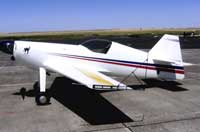Apr 22 2008
Unidym, Inc, a majority-owned subsidiary of Arrowhead Research Corporation, announced today the first flight of an aircraft incorporating Unidym's carbon nanotubes into its airframe for increased strength and flexibility to combat the effects of aerodynamic stress and engine vibration. On April 11th Avalon Aviation's Giles G-200 aircraft flew with Unidym's carbon nanotubes incorporated into its carbon fiber composite engine cowling. The Giles G-200 is a high performance, single engine fully aerobatic carbon composite aircraft.
 AeroGraphics decorated Giles G-200 similar to the carbon nanotube aeroplane
AeroGraphics decorated Giles G-200 similar to the carbon nanotube aeroplane
High performance aerobatic aircraft are often the industry's test bed for new airframe technology. They are generally subject to increased levels of vibration and stress which typically induce cracking in airframe components. Engine cowlings in particular must endure significant engine vibration while simultaneously twisting and constantly shifting with respect to the rest of the airframe during aerobatic flight. A cowling experiences a variety of stresses from increased G-force and gyroscopic forces as the aircraft is flown to the limit of its performance envelope.
"We are delighted that Avalon Aviation decided to incorporate Unidym's carbon nanotubes into this sophisticated, state-of-the-art aircraft," noted Arthur Swift, Unidym's president and CEO. "For some time now the aerospace industry has been looking into the structural use of carbon nanotubes in high performance, composite airframes. To our knowledge this successful flight is the first time carbon nanotubes have actually been flown as part a major composite component of an aircraft's fuselage."
Avalon Aviation applied carbon nanotechnology to this problem in order to increase the strength, while retaining flexibility, and also to lower the density of the resin used in the cowling's carbon fiber composite material. This weight reduction is a significant secondary benefit as the Giles G-200 typically experiences between +10 and -10 times the force of gravity as it performs some of the most difficult aerobatic maneuvers possible for a human piloted aircraft. Avalon Aviation's Giles G-200 is flown by nationally recognized US competitive aerobatics pilot, Greg Howard.
"We've applied Unidym's technology in a critical area of the Giles G-200," said Greg Howard, Chief Pilot and co-owner of Avalon Aviation. "We are constantly looking for ways to reduce any potential composite failures due to vibration and other forms of stress. We are excited about potential composite applications of carbon nanotechnology and look forward to learning more from this initial application in order to expand the use of nanotubes elsewhere in our aircraft."
Avalon Aviation's Giles G-200 will be flown in several major air shows this year. It will also fly in a number of competitive aerobatic events this summer and in the US National Aerobatic Championships in September. Avalon Aviation will be providing technical services this summer at the Advanced World Aerobatic Championship and its Giles G-200 will be featured in the event's concluding, international air show.